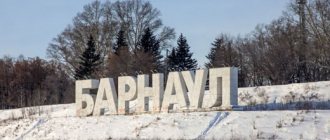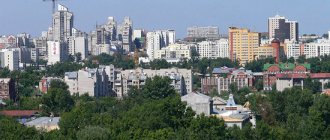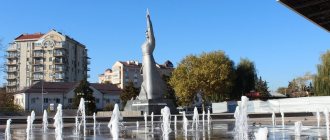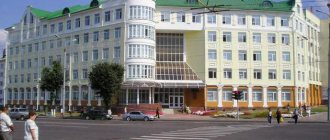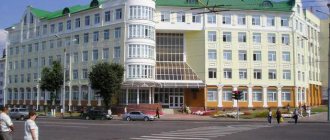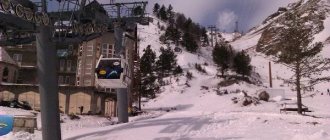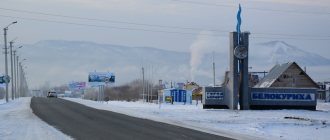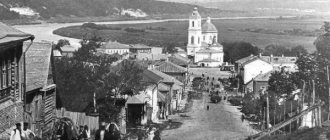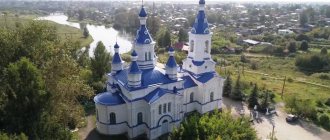- June 8, 2019
- Directions
- Lena Leto
The city of Barnaul (Altai Territory) is not a particularly popular destination for tourism, although it has its own history and a number of interesting attractions. Many people have a hard time imagining where it is and don’t know anything about its specifics. We will tell you about the capital of the Altai Territory, its history, geography, population and the most interesting sights.
Where is
Many residents of the European part of Russia, hearing the phrase “city of Barnaul,” ask the question: “Where is it?” And this is not surprising, because this city is separated from Moscow by 3 thousand kilometers. And the Altai Territory in Russia is not the most important and famous region. However, it is worth understanding that Barnaul is located in the south of Western Siberia, at the confluence of the Barnaulka River and the Ob. The city is surrounded on one side by the Ob River, and on the other by a ribbon forest.
Barnaul is the only city in Russia that is located on the banks of a large river, but only one bank of it is developed. The city has long dreamed of starting to expand towards Novoaltaisk, on the right bank, but these plans remain unrealized. The city is located in the forest-steppe zone, characterized by a predominantly flat landscape. The city area is also mostly flat with a few small hills. The nearest large city is Novosibirsk, 239 km away.
Znamensky Monastery
The religious attractions of the city include the active women's Orthodox Znamensky Monastery. A wooden temple was erected on the site of the future religious building in 1754.
In 1778 this small building was dismantled. Then a church with two altars was built on its foundation.
80 years later, a modern stone building was erected on this site. It was consecrated in honor of the icon of the Mother of God “The Sign”. At that time, three Orthodox schools and a library functioned at the cathedral.
In 1937, the temple was closed and used as the state archive of the Altai region. After 55 years, the religious building was returned to the Russian Orthodox Church (Russian Orthodox Church).
According to the decision of the administration of the Russian Orthodox Church (Holy Synod), since 1994 the Znamensky Cathedral has been transformed into a functioning convent. Tourists can explore the territory of the shrine and attend the liturgy, which takes place daily at certain hours.
Climate and ecology
The capital of the Altai Territory has an unusual geographical location, which affects its climate. It is exposed to air masses from the Atlantic, the steppes of Central Asia and the Arctic Ocean. Only the Altai Mountains protect it from the eastern winds. Therefore, the climate in the Barnaul region is sharply continental. It is characterized by significant contrasts in weather. There are moderately snowy, frosty winters and warm, moderately humid summers. The region has a fairly high rate of sunshine - 2180 hours, for example, in Sochi it is 70-80 hours more. Barnaul has pronounced seasonal variations; there is a noticeable difference between spring, summer, autumn and winter.
The ecological situation in the city is quite satisfactory. Since in the capital of the Altai Territory there have been noticeably fewer industrial enterprises in recent years, the air has become cleaner. In winter, the situation is only worsened by private houses that are heated with coal, but there are fewer and fewer of them due to gasification. Transport is a major contributor to air pollution, but is not currently an environmental problem. But the situation with solid household waste is acute. All areas around the city are turning into unauthorized landfills, and this has a negative impact on the condition of the unique belt forest, which goes directly to the city. The forest is also threatened by logging, which is being carried out for the construction of residential buildings.
Weather in the city by month. Best time to travel
Like everywhere else on this hemisphere of the planet, in Barnaul the highest air temperature occurs in July, and the coldest in January. The minimum winter temperature drops to -20-21°C in January-February. But this is not necessarily always the case, winter can be relatively warm, only -9-12°C, for Russia this is considered a very mild winter climate.
Frosts can last until April, dropping to -1° at night, but during the day the weather is normal spring, the temperature rises to +10°. In May, the frosts disappear completely, and even at night the air temperature drops no lower than +6°. During the day, spring is already in full swing, +20° outside, approaching summer. It's starting to rain.
Barnaul is the administrative center of the Altai Territory with a population of 632,372 people
For this region, 7 days a month of rain is the maximum, and it falls just in May-June.
In the summer, from June to August, the weather is typical for the subtropics, summer weather, maximizing the temperature to 24-26°C. In September, the temperature drops sharply, the nights become cooler, up to +5 maximum, the first cold weather comes in October. Autumn rains begin, lasting until December.
It is better to visit Barnaul for tourism purposes in summer, in warm weather. In winter, cold air from the river lowers the temperature and humidity.
Administrative division
The banks of Barnaulka are considered to be the place from which the city began to grow. The Ob River in Barnaul became a natural barrier that the city did not cross. Therefore, the entire settlement was located on the left bank of the large river. The city is divided into 5 administrative districts: Central, Zheleznodorozhny, Oktyabrsky, Leninsky and Industrial. The city also includes 24 settlements: the villages of Yuzhny, Borzovaya Zaimka, etc. The local population of Barnaul also divides the city according to the traditional names of settlements or places that are included within the city. So, here you can hear such toponyms as Aviator, Solnechnaya Polyana, VRZ, Sulima, Cheryomushki.
How to get there?
Where is Barnaul located? In what area is the city located and how to get there? Those who want to relax in the nature of the Altai Territory, see the sights of the regional center - the city of Barnaul, and communicate with the hospitable indigenous population can use air services. The flight from Moscow will take approximately 4 hours.
You can also get from Moscow by train “Moscow-Barnaul” from Kazansky station. Travel time is 50 hours.
There is also an intercity bus service “Moscow-Barnaul” to Barnaul. Travel time is no more than 65 hours.
Economy
The capital of the Altai Territory, its economic center in Soviet times was a fairly large industrial city. After the collapse of the USSR, many industrial enterprises ceased to exist, and the city began a slow decline. Today, the city has several large enterprises in the chemical, engineering and metalworking industries. There are also many successful agricultural processing enterprises in Barnaul. This is not surprising, because the Altai Territory is an agricultural region. But still, most of the population of Barnaul is engaged in trade. The city has many shopping centers and various commercial enterprises. Important for the city's economy is its convenient location at the intersection of some important transport routes. Barnaul has its own airport named after. G. Titov, a branch of the West Siberian Railway passes through the city.
Intercession Cathedral
We already know where Barnaul is located. Let's talk about one more of its attractions. Since 1898, in the western part of the city, at the expense of the population, on the site of the old wooden Church of the Intercession, construction began on the red brick four-altar Church of the Intercession. The cathedral was consecrated in 1904 in honor of the Intercession of the Holy Virgin.
In 1937 the temple was closed. And its building was used for city needs, and the frescoes that decorated the temple interior and the bell tower were damaged. In 1944, at the request of the diocese of Barnaul, services were resumed in the church. Then the gradual restoration of the church began, which lasted until 1993.
During this time, frescoes based on religious paintings by artists Viktor Vasnetsov, Ivan Kramskoy and other Russian painters, a bell tower and the building of a Sunday Orthodox school for youth of the Barnaul region were restored. Now the Intercession Cathedral is a functioning temple and is open to everyone.
Population
At the end of 2022, 632 thousand people lived in Barnaul. Over the past couple of years, the number of residents of Barnaul has been decreasing. This can be explained by migration and natural decline. The capital of the Altai Territory is a fairly compact city, its area is 322 km². The population density is 1955 people/km². By gender, the groups of city residents are 55% women, 45% men. In terms of ethnic composition, the city differs little from many other settlements in the country. 95% of Russians live here, other nations are represented by groups of less than 1%.
Museum of Auto Theft named after. Yuri Detochkina
On Koptevskaya Street, in the building of the Favorit Motors car dealership, a kind of museum has been operating since 2003. It has become popular among tourists - the auto theft museum, named after the main character of the comedy "Beware of the Car". There is an exhibition of various master keys and devices used by car thieves in the city.
The museum was created on the initiative of the regional rescue service. She subsequently provided him with all the videos of the traffic accidents. Visitors can watch them in a specially equipped cinema hall.
City `s history
In the place where Barnaul is located today (Altai Territory), the first people lived back in the Stone Age. And even before the Russians appeared in this region, the Horde fortress Abaksha stood in this place, from which the Teleuts carried out devastating raids on neighboring settlements. But the real history of the city of Barnaul begins in 1730, when the miner Akinfiy Demidov organized the first settlement to build a copper and silver processing plant. When the plant started operating, people from all over the area flocked to the city. A whole group of St. Petersburg engineers and officers arrived to work at the plant. In 1748, the office of the mountain district was moved from Kolyvan to Barnaul. In 1771 it acquired the status of a mountain town. Barnaul is being built on the model of St. Petersburg. A library, a theater house, and a local history museum appeared. The city is becoming not only a mountainous city, but also a cultural and educational center of the region. But gradually mining fell into decline, and at the end of the 19th century Barnaul became a merchant city. When the railway came to the region, the merchants abandoned the plan according to which the line would pass through Barnaul. And this had a negative impact on the development of the city, which gradually lost its regional significance.
In 1917, a terrible fire occurred in Barnaul, which destroyed 40 city blocks. Restoration began only after the 19th century, already under Soviet rule. During the Soviet era, the city developed as a large industrial center; a number of factories opened here, some of which were evacuated here during the Second World War. After the collapse of the USSR, the city experienced difficult times associated with the closure of a large part of industrial enterprises. Today, the city is regaining its status as a major center of the agro-industrial sector; large residential construction is underway here, although difficulties in the development of the city remain, this is confirmed by the large number of citizens leaving.
Theaters and museums of Barnaul
Barnaul on the map of Russia is famous not only for its architectural monuments, but also for its folk art. From the beginning of the 20th century, creative groups of various profiles began to gather in the city.
A brief overview of the sights of Barnaul:
Some showed performances in the name of the revolution, some staged puppet shows, and some collected fossils and paintings in order to, in the future, convey to the city and the entire Altai region the cultural heritage of the ancestors of the northerners, whose descendants continue their activities in local museums and theaters
Art Museum
In the mid-20th century, namely in 1959, the Soviet authorities ordered the construction of a museum to house the gallery of Peter Frolov , which he had been collecting since 1823. The paintings wandered from one place to another until they found their home in the Altai Museum.
The gallery has about 13,000 exhibitions , which include works by artists Kuprin, Malevich, Krymov, Rembrandt and others. Today, the museum has been restored and actively hosts excursions and art events.
Collections include the work of Russian artists of the 19th-21st centuries, as well as Orthodox paintings, sculptures, copper castings and more.
Museum of Local Lore
The building, which currently houses the local history museum of the Altai region, previously belonged to chemists and laboratory assistants of the mining industry. But, at the end of the Russian Empire, in 1913, the emperor ordered the chemists to vacate the building and transfer it to the museum.
Before this, the exhibitions collected by Pyotr Frolov and Friedrich Gebler were located in a different location and were closed to ordinary citizens. Samples included the work of Russian northerners and Native Americans, herbariums, models of mining machines and mechanisms, which had been collected in the collection since the 18th century.
At the moment, the museum is open and conducts excursions for children and adults on natural history, scientific conferences and creative evenings.
Museum "World of Stone"
The Altai region has long been famous for the presence of minerals. The very first industries were built to extract and process them, including one of the first silver smelters. After some time, the plant closed, and in its place a museum of fossils, found at the excavation site for many years, was opened.
The museum is now open to the public and features rocks, minerals and fossils from around the world , including North America, Europe and Oceania. A separate part of the museum is reserved for storing and displaying Altai fossils. The organizers also organize regional and interregional excursions for children and adults.
Altai Regional Drama Theater
The Drama Theater was built in 1921 in the very center of Barnaul according to the design of the Central Institute. In 1991, the city administration decided to name the theater in honor of the film director, Lenin Prize winner Vasily Shukshin. In 2007, the inside of the building was reconstructed and updated to the latest standards.
The theater includes a main auditorium with 711 seats and an experimental stage with 182 seats. The repertoire today has an extensive program, showing dramas, comedies and plays for 12+, 16+ and 18+.
Altai Youth Theater
The Theater for Young Spectators was created by amateurs from several people in 1918. After wandering around parks and apartments for 40 years, the theater group was given the first premises in the Altai Drama Theatre. And only in 1999 the troupe finally settled in the current building of the House of Culture on October Square, which previously belonged to the textile industry organization.
The artists' repertoire included plays for children and adults, mostly of a Soviet, revolutionary nature. Over time, the poster was modernized, and now the artists’ repertoire includes productions based on the books of A. Ostrovsky, V. Sigarev, A. Chekhov, A. Arbuzov, V. Gauf, I. Goncharov and many others.
Theater "Fairy Tale"
The first puppet theater troupe was formed in 1938. The puppeteers did not have their own building, wandering here and there. During front-line times, artists traveled, giving performances on military topics. The theater first received a building in 1963 in the Philharmonic, then on Pushkin Street, and then on Lenin Avenue, which belonged to the Rodina cinema.
Now the theater shows performances for the youngest children from 2 years old and for older children, 6-8 years old. The repertoire includes classics (Little Red Riding Hood, Alice in Wonderland) and modern productions (The Four Seasons, The Gosling, The Hare's Hut).
The theater also opened a school for young puppeteers, where teachers teach children aged 5-7 years old the art of puppet theater.
Culture
Like other large cities of the Altai Territory, Barnaul has a cultural life, although it cannot be called too vibrant and diverse. There are 4 state theaters and a philharmonic society in Barnaul, as well as several private small theaters. There are also several museums and art galleries in the city. The newest museum is the Mountain Pharmacy, a restored original 19th-century pharmacy. Also in Barnaul there is an unusual auto theft museum named after Yuri Detochkin and a museum of time, which contains household items from the 19th and 20th centuries. Children especially love the interesting museum of entertaining sciences “How so?” During Soviet times, Barnaul had an extensive network of cinemas. Today, this area is represented by the Kinomir chain and individual cinemas Pioneer, Matrix and Formula.
Where to go with children in Barnaul
Coming to the glorious city of Barnaul with children, every parent wants to introduce their child to history by arranging for him an interesting excursion that will not be tiresome. To do this, there are many interesting places where you can take the new generation.
In the local history museum, educational programs for children and a competition for the best postcard are planned for January 2022 . The child will be able to take part in the Creativity Laboratory and attend a master class on creating a Christmas angel. Events take place on the street. Polzunova 39.
The city's theaters also have a program designed for both the youngest spectators, 2-year-olds, and older children. At the Skazka puppet theater in January 2022, young spectators will be able to see the performances “Morozko”, “Snowman-Postman”, “Emelya’s New Year’s Journey”, “The Three Little Pigs”, “Mashenka and the Bear” and others.
The performances are designed for children aged 2-4 years.
The local Minotaur Labyrinth , which hosts various quests, attractions and horror labyrinths, is very popular among teenagers. The price of a ticket to different rooms is from 100 to 400 rubles. The recently popular excursion “With Eyes Closed” for children 10-15 years old offers an individual quest to identify hidden abilities.
The child learns to explore the world by touch, discovering previously unknown capabilities of his brain. The price of the excursion is 1500 rubles.
The city constantly hosts excursions to local attractions, to the Altai knitting factory, to the shoe and terry products factory, at a price of 250 rubles. per person. A child can watch how halva is made at a halva factory; the ticket price is 300 rubles. You can also look at animals, namely ostriches for 200 rubles. or visit the rare bird nursery for 750 rubles.
Barnaul - the capital of the world
Many cities have their own legends and myths, persistent stereotypes. There is one in the capital of the Altai Territory. There is a half-joking saying in the city: “Barnaul is the capital of the world.” It appeared during the period of perestroika. There are several versions of who first said it. But most of the local residents say that it was first heard in the song of the local rock band The 9. And later it was picked up by the writers the Orekhov brothers, who wrote fantastic stories and created a story called “Barnaul - the capital of the world”, the prototype of which was one of the characters musician of the group “9” Sergei Lazorin. This phrase became a kind of slogan for the avant-garde creative youth of the 90s. Now this expression has become part of local folklore and is popular among middle-aged Barnaul residents.
Where to eat in Barnaul: cafes and restaurants
The Altai capital is rich in a variety of cuisines with different pricing policies. In every restaurant or cafe you can find exquisite, signature dishes, as well as homemade, traditional cuisine familiar to every Russian resident. The table shows prices for the most popular dishes and drinks.
Catering establishments are located in different parts of the city.
| Institution | Address | Approximate prices |
| "Ieroglyph" (sushi bar) | Socialist Ave., 109 |
|
| Gold of Packard (restaurant) | st. Malakhova, 94b |
|
| Velvet (restaurant) | Lenin Ave., 80 |
|
| "Pozharka" (grill bar) | Zmeinogorsky truck, 71v |
|
| "Beer restaurant" (restaurant) | st. Vzletnaya, 57 |
|
| “Gastronomica” (cafe-restaurant) | st. Anton Petrova, 176b |
|
| "Ku-Ku" (restaurant complex) | Kalinina Ave., 1a |
|
On the map of Russia there are many large and small cities with a rich history, always ready to receive tourists from Russia or abroad. Barnaul is one of these cities, with familiar and at the same time original architecture, delicious cuisine and cozy hotels.
Coming to the center of Altai, you pay attention to how local residents love their city and are sensitive to its condition and development. Every visitor will experience how harmoniously the centuries-old history of the city, captured in architectural monuments, and modern hospitality are combined.
Article design: E. Chaikina
Attractions
When tourists plan to visit the Siberian city of Barnaul, they think about what they can see there. The first thing guests arriving by car see are large white letters in Nagorny Park a la Hollywood, as well as a long bridge across the Ob River. They also have a view of the old city, where the main attractions are concentrated. These include monuments of wooden architecture, in particular the House of the architect Lesnevsky, the house of the merchant Shadrin, the house of the architect Nosovich. The turn of the 19th and 20th centuries is represented by several beautiful stone mansions. The most interesting are the house of merchants Yakovlev and Polyakov, the Philharmonic building, the former People's House, and the city hall building. The Soviet period was the time when the complex of the city’s main street, Lenin Avenue, was formed. It is built up with buildings in the Stalinist Empire style. The most striking building of the Soviet period is the House under the Spire, which has become a real symbol of the city. Important architectural monuments are the city's cathedrals - Pokrovsky, Nikolsky, Znamensky.
Monuments and monuments of Barnaul
Barnaul on the map of Russia, which is the center of the Altai region, has become the site of the construction of monuments to history and its figures, which are important for the country and Siberians in particular. The monuments bear not only a tribute to historical dates, but also the creative component of the city, in which both workers and artists live, who also have their own heroes.
When visiting Barnaul, you will notice that some monuments have a hidden meaning, which can only be understood by learning the history of the city itself.
Demidov pillar
Another work by Pyotr Frolov, who donated a gallery of paintings and a collection of Altai fossils to the city. This time, the engineer decided to give the city a granite obelisk, 14 m high, in honor of the 100th anniversary of mining in Altai. The opening of the memorial sculpture took place in 1839 , 14 years after the installation of the first stone.
The cone-shaped obelisk consists of 12 blocks and is located on Demidovskaya Square. In 1918, the Bolsheviks wanted to move the monument to another place, erasing its history and dedicating the building to the achievements of the revolution. But the pillar was so strong that it was impossible to disassemble and engrave anything on it.
Monument to V.M. Shukshin
The monument dedicated to the artist Vasily Shukshin was donated to the city in 1989 , on the 60th anniversary of the film director. He did not live to see this event, having died 14 years before this event. The monument depicts a thoughtful Shukshin sitting on a stone.
The attraction is located in the Leninsky district of the city and every year attracts fans of the artist’s work.
Monument to IDPs
In 2012, a significant artistic monument to the first peasants who moved to the Altai region and were engaged in agriculture was erected on Kalinin Avenue. It was these people who raised the city, providing provisions to all the city's residents.
The monument depicts an old peasant sowing and a boy next to him against a background of sun, clouds and trees.
Zero kilometer
Stone cutters from Barnaul presented their city with an original and simple monument, marking the beginning of all roads in the village. The opening took place in 2003 on Soviet Square. The structure consists of 8 blocks on which there is a stone vase. On the sidewalk there is a drawing in the form of a circle with 12 zodiac signs.
In essence, the monument is a sundial, which can be used to accurately determine the time on a sunny day.
Victory Monument
The monument, commemorating the victory of the Soviet people over fascism, was erected in honor of the 20th anniversary of the victory in 1975 on the square of the same name. This 24-meter-tall structure is a stela on which, on one side, soldiers and the years of the beginning and end of the war are depicted, and on the other, ordinary people who lived and supported the city in difficult times.
Things to do
The city is not only architecture and monuments, but also parks and squares. In Barnaul, the beautiful Ob embankment has recently been decorated, along which you can take pleasant walks. The city is located on the border with a unique ribbon forest, where you can also take pleasant walks. You can also spend a few pleasant days in sanatoriums and holiday homes. The Altai region is famous for its beautiful nature and there are several excellent places to relax right within the city limits. You can also go for a walk to the arboretum, which is especially beautiful in the spring, when many varieties of lilac, apple and cherry trees bloom.
Demidovskaya Square
The walking tourist excursion begins with the main attraction of the city - Demidov Square. It is located in the central part
In 1818, the managers of the Kolyvan-Voskresensky factories, Pyotr Frolov, proposed creating a square in Barnaul where an obelisk could be erected in honor of the 100th anniversary of the start of mining in the Altai region.
Initially the square was called Konyushennaya. Then it changed its name several times.
From 1992 to the present time, the main square of Barnaul is called Demidovskaya in honor of the founder of the city, Akinfey Demidov. Now it looks about the same as it did in past centuries.
Tourists can explore the buildings of the mountain hospital, mining school and home for the disabled. All these buildings date back to different years of the 19th century and have retained their original appearance.
Automobile highways
Two federal highways pass through the city of Barnaul:
- P256 “Chuysky Trakt” is a federal highway with a total length of 962 km. The route starts in Novosibirsk and goes to the state border with Mongolia. Passes through Biysk, Barnaul, Novoaltaysk, Mayma, Yarantai. Part of the Asian route AH4. The road surface of the route is asphalt concrete.
- A322 is a highway that has the status of federal significance. The total length of the route is 332 km. The road originates in Barnaul and moves in a southwestern direction - to the border with Kazakhstan. Part of the Asian route AH64. The road surface of the route is asphalt.
